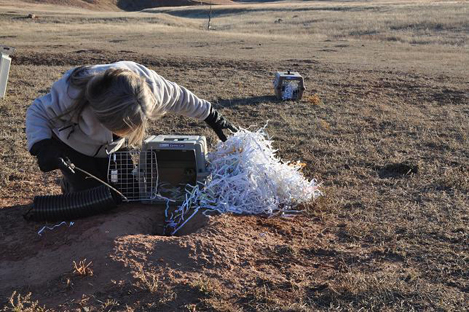44.1: 生态学的范围
- Page ID
- 202956
培养技能
- 定义生态学和生态研究的四个层次
- 举例说明生态学需要整合不同科学学科的方式
- 区分环境的非生物和生物成分
- 认识环境中非生物和生物成分之间的关系
生态学是研究活生物体与其环境的相互作用。 生态学的核心目标之一是了解物理环境中生物的分布和丰度。 实现这一目标需要整合生物学内外的科学学科,例如生物化学、生理学、进化、生物多样性、分子生物学、地质学和气候学。 一些生态学研究还应用了化学和物理学的各个方面,并且经常使用数学模型。
生态研究水平
在研究生物学等学科时,将其细分为较小的相关领域通常会很有帮助。 例如,对细胞信号传导感兴趣的细胞生物学家需要了解信号分子(通常是蛋白质)的化学成分以及细胞信号传导的结果。 对影响濒危物种生存的因素感兴趣的生态学家可能会使用数学模型来预测当前的保护工作如何影响濒危生物。 为了制定一套合理的管理方案,保护生物学家需要收集准确的数据,包括当前的种群规模、影响繁殖的因素(如生理和行为)、栖息地要求(例如植物和土壤)以及人类对濒危种群的潜在影响它的栖息地(可能来自社会学和城市生态学研究)。 在生态学学科中,研究人员在四个特定层面上工作,有时是分散的,有时是重叠的:生物、种群、群落和生态系统(图\(\PageIndex{1}\)).

Organismal Ecology
Researchers studying ecology at the organismal level are interested in the adaptations that enable individuals to live in specific habitats. These adaptations can be morphological, physiological, and behavioral. For instance, the Karner blue butterfly (Lycaeides melissa samuelis) (Figure \(\PageIndex{2}\)) is considered a specialist because the females preferentially oviposit (that is, lay eggs) on wild lupine. This preferential adaptation means that the Karner blue butterfly is highly dependent on the presence of wild lupine plants for its continued survival.

After hatching, the larval caterpillars emerge and spend four to six weeks feeding solely on wild lupine (Figure \(\PageIndex{3}\)). The caterpillars pupate (undergo metamorphosis) and emerge as butterflies after about four weeks. The adult butterflies feed on the nectar of flowers of wild lupine and other plant species. A researcher interested in studying Karner blue butterflies at the organismal level might, in addition to asking questions about egg laying, ask questions about the butterflies’ preferred temperature (a physiological question) or the behavior of the caterpillars when they are at different larval stages (a behavioral question).

Population Ecology
A population is a group of interbreeding organisms that are members of the same species living in the same area at the same time. (Organisms that are all members of the same species are called conspecifics.) A population is identified, in part, by where it lives, and its area of population may have natural or artificial boundaries: natural boundaries might be rivers, mountains, or deserts, while examples of artificial boundaries include mowed grass, manmade structures, or roads. The study of population ecology focuses on the number of individuals in an area and how and why population size changes over time. Population ecologists are particularly interested in counting the Karner blue butterfly, for example, because it is classified as federally endangered. However, the distribution and density of this species is highly influenced by the distribution and abundance of wild lupine. Researchers might ask questions about the factors leading to the decline of wild lupine and how these affect Karner blue butterflies. For example, ecologists know that wild lupine thrives in open areas where trees and shrubs are largely absent. In natural settings, intermittent wildfires regularly remove trees and shrubs, helping to maintain the open areas that wild lupine requires. Mathematical models can be used to understand how wildfire suppression by humans has led to the decline of this important plant for the Karner blue butterfly.
Community Ecology
A biological community consists of the different species within an area, typically a three-dimensional space, and the interactions within and among these species. Community ecologists are interested in the processes driving these interactions and their consequences. Questions about conspecific interactions often focus on competition among members of the same species for a limited resource. Ecologists also study interactions among various species; members of different species are called heterospecifics. Examples of heterospecific interactions include predation, parasitism, herbivory, competition, and pollination. These interactions can have regulating effects on population sizes and can impact ecological and evolutionary processes affecting diversity.
For example, Karner blue butterfly larvae form mutualistic relationships with ants. Mutualism is a form of a long-term relationship that has coevolved between two species and from which each species benefits. For mutualism to exist between individual organisms, each species must receive some benefit from the other as a consequence of the relationship. Researchers have shown that there is an increase in the probability of survival when Karner blue butterfly larvae (caterpillars) are tended by ants. This might be because the larvae spend less time in each life stage when tended by ants, which provides an advantage for the larvae. Meanwhile, the Karner blue butterfly larvae secrete a carbohydrate-rich substance that is an important energy source for the ants. Both the Karner blue larvae and the ants benefit from their interaction.
Ecosystem Ecology
Ecosystem ecology is an extension of organismal, population, and community ecology. The ecosystem is composed of all the biotic components (living things) in an area along with the abiotic components (non-living things) of that area. Some of the abiotic components include air, water, and soil. Ecosystem biologists ask questions about how nutrients and energy are stored and how they move among organisms and the surrounding atmosphere, soil, and water.
The Karner blue butterflies and the wild lupine live in an oak-pine barren habitat. This habitat is characterized by natural disturbance and nutrient-poor soils that are low in nitrogen. The availability of nutrients is an important factor in the distribution of the plants that live in this habitat. Researchers interested in ecosystem ecology could ask questions about the importance of limited resources and the movement of resources, such as nutrients, though the biotic and abiotic portions of the ecosystem.
Career Connection: Ecologist
A career in ecology contributes to many facets of human society. Understanding ecological issues can help society meet the basic human needs of food, shelter, and health care. Ecologists can conduct their research in the laboratory and outside in natural environments (Figure \(\PageIndex{4}\)). These natural environments can be as close to home as the stream running through your campus or as far away as the hydrothermal vents at the bottom of the Pacific Ocean. Ecologists manage natural resources such as white-tailed deer populations (Odocoileus virginianus) for hunting or aspen (Populus spp.) timber stands for paper production. Ecologists also work as educators who teach children and adults at various institutions including universities, high schools, museums, and nature centers. Ecologists may also work in advisory positions assisting local, state, and federal policymakers to develop laws that are ecologically sound, or they may develop those policies and legislation themselves. To become an ecologist requires an undergraduate degree, usually in a natural science. The undergraduate degree is often followed by specialized training or an advanced degree, depending on the area of ecology selected. Ecologists should also have a broad background in the physical sciences, as well as a sound foundation in mathematics and statistics.

摘要
生态学是研究生物与环境的相互作用。 生态学家在生物组织的四个层面提出问题——生物、种群、社区和生态系统。 在生物层面,生态学家研究单个生物及其与环境的相互作用。 在种群和群落层面,生态学家分别探索生物种群如何随着时间的推移而变化,以及该种群与群落中其他物种相互作用的方式。 研究生态系统的生态学家研究生态系统的活物种(生物成分)以及环境中的非生物部分(非生物成分),例如空气、水和土壤。
词汇表
- 非生物的
- 环境的非生命成分
- 生物的
- 环境的活组成部分
- 同类的
- 属于同一物种的个体
- 生态学
- 研究生物与其环境之间的相互作用
- 异种的
- 属于不同物种的个体




